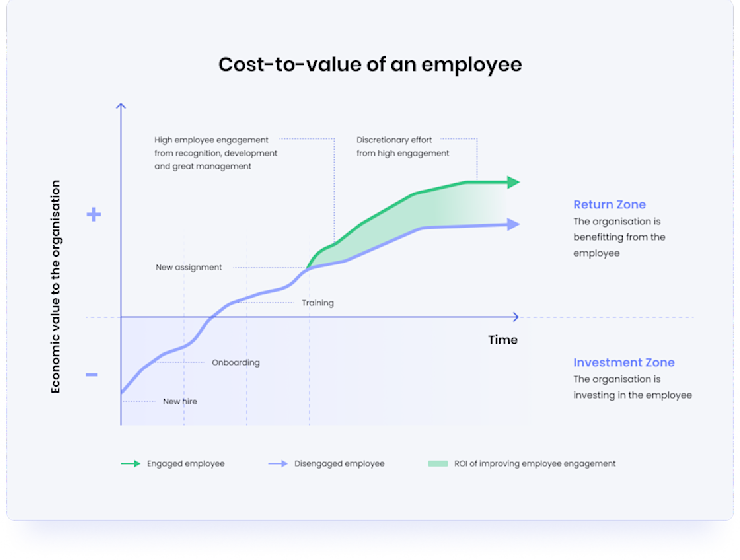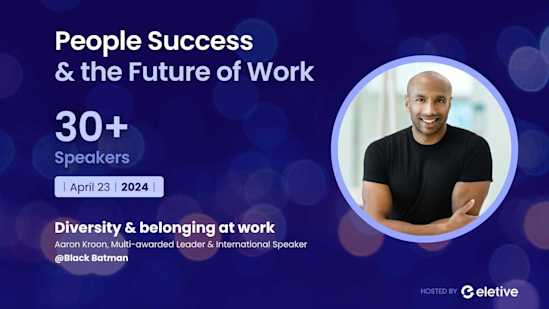Mapping and understanding the employee journey helps you improve employee engagement and employee retention – throughout the employee lifecycle.
What is an employee journey?
The employee journey is a map of the experience an employee has at an organisation, from the very first touch point to the last and beyond. It can be described in six steps, with recruiting and exiting being the first and last steps. Employee journey mapping is a great way to get an overview of the employee’s experience and what can be done to improve the company culture and employee satisfaction.
The benefits of employee satisfaction are many. Mapping and understanding the employee journey can help to manage and improve employee satisfaction and engagement in every stage. A better employee experience will help you increase employee retention and reduce unwanted attrition.
In this blog post, we’ll have a closer look at the different steps of the employee journey:
Recruitment
Employee onboarding
Integration and employee performance
Employee learning and development
Offboarding and exit interviews
Post-exit employees
Why is understanding the employee journey so important?
Employee onboarding is a costly process, and it takes time to make a return on that investment. The cost-to-value curve below describes how long it takes for a new hire to start contributing with economic value to the organisation. Very few people are profitable from day one, as there is usually a learning curve when starting a new position.

The cost-to-value curve shows that employee engagement and longevity are especially important. Managing engagement to reduce employee turnover is important for organisations to see an increased economic value.
The different stages of the employee journey
1. Recruitment
The employee journey starts before an employee is even hired, with the very first interaction they have with your organisation. The different touchpoints of this stage include seeing your ads, reading on your career site, researching your company on employer review sites, and talking to your recruiters. It may also include talking to your current employers, or people who have previously worked at your company. All these things together will shape a candidate's first impression of your organisation.
2. Employee onboarding
Once a candidate has decided to join your organisation as an employee, the next crucial step begins: the onboarding process. This is a crucial part of the employee journey and it will not only determine how your employee feels about their new job but also how quickly they can get up-to-speed and start contributing. The more efficient your onboarding journey is, the shorter the time-to-value of each hire will be.
3. Integration and employee performance
In this step, employees are beginning to settle into the organisation and carry their enthusiasm from onboarding into their practices and begin to take steps toward their goals. This step in the journey is where the new employee starts to involve themselves and participate in the daily tasks. The focus here for employers is to continue to engage with the employees to get total employee involvement and make them feel recognised. Simultaneously, drivers of employee engagement should be integrated and implemented so that the new employees feel engaged at work.
4. Employee learning and development
This is the step in the journey where the employee is most productive. They know the organization, how to perform the daily operations, and are well accustomed to the company culture. Following Maslow’s hierarchy of needs, this is also where employees want to grow and develop as human beings to feel satisfied.
For employers, the objective is to prolong this step in the journey. By managing employee satisfaction, engagement levels, and overall job happiness through employee pulse surveys and job satisfaction questionnaires, managers are taking important measures towards ensuring a positive company culture where employees get the possibility to thrive.
5. Offboarding and exit interviews
The offboarding step is the second to last step in the employee journey. This is where the employee feels that they no longer want to work at an organisation and notifies the employer that they want to leave.
Unfortunately, situations like these are impossible to avoid. But when employees get to this step, employers must be ready and use it to get better and understand why an employee is leaving. One example of this is to conduct exit interviews with the employee to understand why they are leaving, and what they could have done to prevent it.
When an exit interview is done, try to depart in the best way possible because that employee might still be useful to you in the final step of the employee journey.
Tip: Be proactive and do stay interviews to increase understanding so that changes can be made before reaching the offboarding step!
6. Post-exit employees
When there is mutual respect between an employee and an organisation, the employee can still be valuable even after offboarding and exiting the organisation. One of the bonuses of having high eNPS is that it turns employees into great marketers for the organisation.
This is true for employees that only have positive things to say about their previous job. They can spread the word to other people in their network about your organisation and help push new talent into the first step of the employee journey. Thus, completing their journey and aiding in starting a new one, finalising the employee journey.
Segment the organisation and create multiple journey maps
It’s usually beneficial to create multiple employee journey maps and segment employees into the right map based on factors such as job description and age. Employee journey mapping is a constantly ongoing process. By evaluating relevant information at every step of the journey, employers gain deeper insights into what might be improved in each step to ensure high employee satisfaction, engagement, and well-being.
Employee engagement through the whole employee journey
Eletive is a People Success Platform that can help HR managers and people leaders map and monitor the employee journey. By collecting the relevant data at the different touchpoints, Eletive provides real-time insights into employee satisfaction and employee engagement – throughout the employee lifecycle.
FAQ
Why is employee journey mapping important?
Employee journey mapping gives HR teams the opportunity to get an overview of the moments that mean something to employees. With a good understanding of the important moments, it is easier to implement changes from feedback to maintain a high employee engagement level. This will lead to many positives in both employee retention and employee engagement, as well as ensuring that future processes of onboarding are improved.
Should you create more than one employee journey map?
Yes. You should segment your employees and create multiple employee journey maps based on your segmented groups. Experiences and moments of importance will be different for people with different job titles, and the journey maps should get the best overview possible of all the moments and all the employees. A salesperson might have an easier onboarding than an engineer, then it is easier to spot that and make changes to the engineer's onboarding so that it improves in the future.
What are the benefits of employee journey mapping?
The main benefit is that you get an overview of the experiences your employees have at your organisation. From that, you can develop new ideas to improve the experiences of these moments so that they will be better in the future. This will in turn help with increasing employee retention and employee engagement. Engaged staff are more likely to give better service to customers and in that way increase value for organisations.






